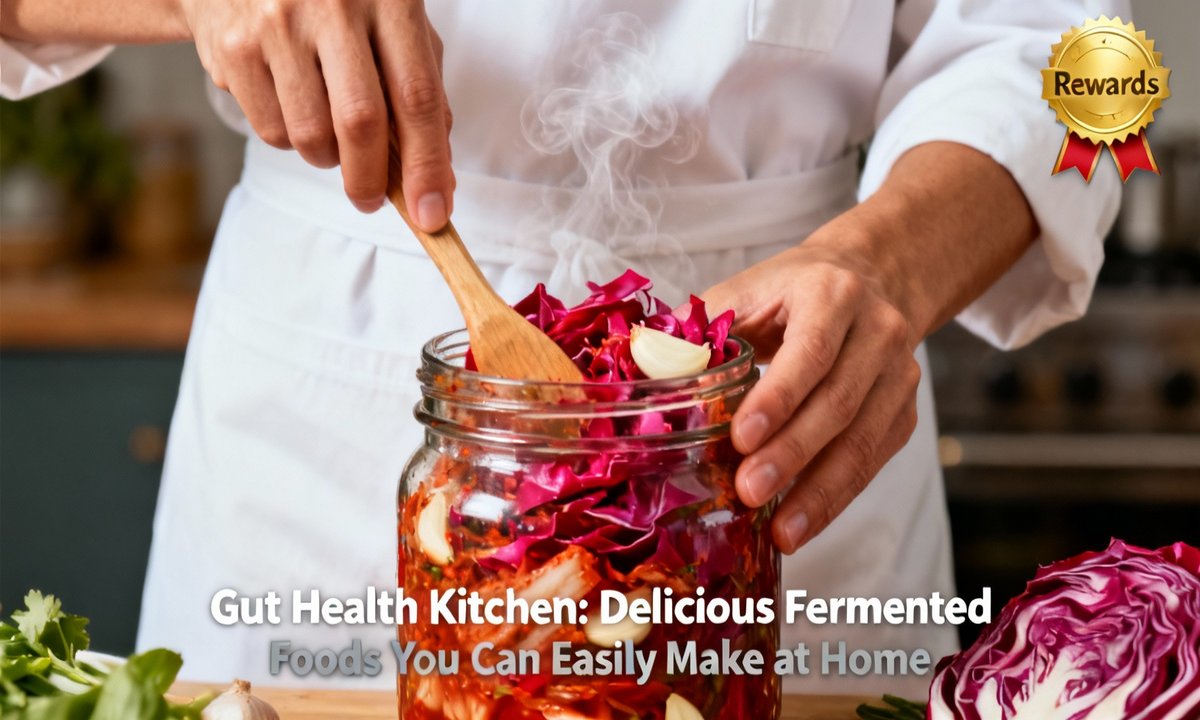Fermentation is making a significant return to kitchens, offering vibrant flavors, a delightful zing, and invaluable probiotic benefits. This ancient culinary art is more accessible than you might imagine, requiring only simple ingredients and a few jars to begin your journey into homemade fermented foods. It’s a rewarding process for both novice and experienced cooks.
The Ancient Art of Fermentation: Revitalizing Modern Kitchens
Fermented foods have long been a cornerstone of diets across diverse cultures, celebrated for centuries. Today, their distinctive tangy tastes and gut-friendly properties are gaining immense popularity among health-conscious individuals throughout the US. From German sauerkraut to Korean kimchi, fermentation offers a natural, minimal-ingredient method for preserving food and supporting digestive wellness. Exploring this practice can also connect you with global flavors and traditions.
This natural process harnesses the power of beneficial bacteria, which fortifies foods and helps to bolster the body’s immunity. As you consider new kitchen projects, remember that almost any vegetable can be transformed into a masterpiece that supports your microbiome. The simplicity and effectiveness of fermentation make it an appealing addition to any home.
Why Fermented Foods are Essential for Optimal Gut Health
A thriving gut is fundamental to overall well-being, and fermented foods provide an effortless way to introduce vital probiotics into your daily diet. These live cultures play a crucial role in balancing your gut microbiome, which in turn enhances both digestion and immune response. Enjoying favorites like homemade pickles, kimchi, and sauerkraut offers a delicious route to increased bacterial diversity.
For those interested in healthier meal planning, pairing your homemade ferments with affordable meal prep strategies can provide an additional wellness boost. The remarkable aspect of home fermentation is its ability to support your unique gut health needs without requiring a significant financial investment. It is a truly budget-friendly health habit.
Popular Fermented Foods Trending in the US
American kitchens are increasingly experimenting with creative ferments, moving beyond traditional staples. Many popular options are both delicious and surprisingly easy to prepare at home. These ferments add a unique depth of flavor and nutritional value to any meal.
Kombucha: Effervescent and Customizable
Kombucha is a lightly effervescent tea that is slightly tart and incredibly versatile, allowing for endless flavor customizations. Its bubbly nature and refreshing taste make it a popular choice for those seeking a beneficial beverage. Making it at home offers control over sweetness and fizz.
Kimchi: The Spicy Korean Staple
Kimchi is a spicy Korean classic that can be prepared in either vegan or traditional forms. This fermented cabbage dish offers a vibrant kick and a complex flavor profile, making it a beloved condiment and ingredient. Its rich history and bold taste make it a truly engaging ferment.
Kefir: Tangy, Probiotic-Rich Drinkable Yogurt
Kefir is a tangy, drinkable yogurt that is generously packed with probiotics, offering a creamy and nutritious option. It’s often enjoyed as a refreshing beverage or incorporated into smoothies. This ferment provides a diverse range of beneficial bacteria in a convenient form.
Sauerkraut: Classic Crunchy Cabbage
Sauerkraut is a crunchy, finely shredded cabbage ferment known for its distinctive tang. It pairs wonderfully with a variety of dishes, adding both texture and a burst of flavor. This simple ferment is an excellent entry point for beginners due to its straightforward preparation.
These popular ferments introduce a world of flavor to any meal, perfectly complementing quick dishes like those found in our 20-minute dinners collection. Integrating them into your cooking routine is an easy way to elevate everyday meals with exciting tastes and probiotic benefits.
Simple Fermented Food Recipes You Can Make at Home
Embarking on your journey to make gut-friendly ferments is far less daunting than it might initially appear. The fundamental requirements are simple: fresh vegetables, non-iodized salt, filtered water, and patience as nature takes its course. These beginner-friendly options provide a great starting point for anyone.
Homemade Fermented Pickles
Create crisp and probiotic-rich fermented pickles by combining sliced cucumbers, garlic, and dill with a saltwater brine in a mason jar. Allow them to ferment at room temperature for approximately 5–7 days, then transfer them to the refrigerator for storage. These offer a delightful crunch and tang.
Naturally Sweet Fermented Carrots
Naturally sweet and tart fermented carrots are another excellent choice for beginners. Simply cut carrots into sticks, submerge them in a saltwater brine, and allow them to ferment for one to two weeks. The fermentation process enhances their natural sweetness with a pleasant sour note.
Aromatic Lacto-Fermented Garlic
For an aromatic and health-boosting flavor, consider lacto-fermented garlic. Pack peeled garlic cloves in brine and allow them to ferment for one to three weeks. This process mellows the raw garlic intensity while developing a complex, savory taste. You can learn more about lacto-fermentation for detailed guidance.
Fermentation also serves as an excellent method for utilizing excess or seasonal produce, aligning perfectly with efforts to reduce food waste. Discover more ways to manage your kitchen resources efficiently in our Zero-Waste Kitchen guide.
Spotlight Recipe: Traditional Vegan Kimchi
Kimchi introduces a vibrant heat and vitality to any dining experience. Creating a simple vegan version at home allows you to enjoy its rich, complex flavors. This recipe highlights the core ingredients and an accessible preparation process for a truly engaging ferment.
To begin, you will need approximately 3 lbs of Napa cabbage, 8 oz of daikon radish, and 8 oz of carrot. Essential aromatics include green onions, garlic, ginger, and red pepper, along with about 1 oz of sea salt per 3 lbs of vegetables. These ingredients form the base of this flavorful dish.
Combine and massage the vegetables with salt, then toss them with your chosen spices. Pack the mixture tightly into jars, ensuring it remains submerged under its brine using a weight. Allow it to ferment at room temperature; it will typically be ready in about a week, though taste is the best guide. A detailed step-by-step guide is available here.
Pair this delicious kimchi with your favorite plant-based meals, or find inspiration for new culinary creations in our plant-based dinner collection. Kimchi’s versatility makes it a fantastic addition to many dishes.
Beginner’s Guide to Home Fermentation: Tools, Safety, and Tips
Fermenting foods at home is a refreshingly low-tech endeavor, making it accessible to everyone. You primarily need glass jars (sterilized for hygiene), fresh produce, non-iodized salt, and filtered water. These basic items are sufficient to begin your fermentation projects successfully.
Essential Tools for Fermenting
For optimal results, always ensure your vegetables remain completely submerged beneath the brine. Store your fermenting jars away from direct sunlight in an environment with a consistent temperature, ideally between 70–80°F. These conditions help promote healthy fermentation and prevent spoilage.
Key Safety Guidelines for Fermentation Success
When fermenting at home, always use thoroughly sterilized containers to maintain a clean environment. It is crucial that all vegetables stay submerged under the brine to avoid undesirable mold growth. If you observe any mold forming above the brine or detect an unpleasant odor, it is best to discard the batch and start anew. Always refrigerate your finished ferments to halt the process and preserve their quality.
Considering how fermentation can enhance seasonal produce, it fits perfectly into affordable seasonal eating strategies. Maximizing the value and flavor of ingredients through fermentation is a smart kitchen practice.
How Fermentation Nurtures Your Microbiome
Fermentation goes beyond simply enhancing flavor; it actively transforms raw vegetables into probiotic-rich foods that significantly fortify your gut’s bacterial ecosystem. Regular, small servings of items like kombucha, kimchi, or lacto-fermented garlic can help replenish live cultures, improve nutrient absorption, and promote consistent digestion. Emerging scientific insights continue to confirm these benefits, though individual gut responses can vary. You can read more on this topic to understand the nuances of fermentation and gut health.
For creative ideas on blending these unique flavors into your cooking, explore how our favorite weeknight one-pot wonders can easily incorporate a zingy spoonful of home-fermented foods. This integration adds both taste and health benefits to your meals.
Quick Start: Lacto-Fermented Garlic Recipe
If you’re just beginning your fermentation adventure, lacto-fermented garlic offers a quick and potent starter project. Begin by peeling garlic cloves and packing them snugly into a clean jar. This ensures a compact and efficient fermentation process.
Next, cover the garlic completely with a 2–3% saltwater brine, ensuring every clove is submerged. Use a weight to keep the garlic pressed down, then seal the jar. Allow it to ferment for one to three weeks at room temperature. Once it achieves a pleasant tanginess, transfer it to the refrigerator and enjoy its versatile flavor on toast, in salads, or as a savory addition to various dishes. Further details are available here.
Incorporating Homemade Ferments into Your Daily Meals
Homemade ferments possess the remarkable ability to elevate almost any meal with their distinct flavors. Consider adding curtido to your eggs for a savory twist, incorporating kimchi into vibrant grain bowls, or enjoying pickled carrots as a refreshing, zesty snack. Their versatility is truly impressive.
These ferments pair wonderfully with tacos, enhance grain salads, and add extra zip to stir-fries, contributing to both taste and digestive wellness. Remember, you only need a spoonful or two per meal to experience noticeable probiotic benefits. Small additions can make a significant difference.
Common Questions About Fermentation
Embarking on the journey of home fermentation often brings forth a few common inquiries. Understanding these can help demystify the process and build confidence in your ability to create delicious, healthy ferments. Addressing these questions clarifies key aspects of fermentation.
Are All Fermented Foods Probiotic?
Many traditional fermented foods, such as homemade kimchi, sauerkraut, kefir, and kombucha, indeed contain live cultures that are beneficial. However, many commercial, shelf-stable fermented products are often pasteurized, which eliminates these live probiotics. For optimal gut health benefits, always opt for fresh, refrigerated brands or, ideally, your own homemade versions.
Is Home Fermentation Safe for Beginners?
Absolutely! With a few basic guidelines, beginners can reliably produce delicious and safe-to-eat ferments at home. The key is to always use clean equipment, trust your senses for any off-odors, and not hesitate to discard any questionable batches. Following simple safety protocols ensures a successful and enjoyable experience.
How Do You Know When Ferments Are Ready?
The best indicator of a ready ferment is taste. Most foods will reach their peak flavor within one to three weeks, though this can vary depending on the ambient temperature and your personal preference for tanginess. Regular tasting allows you to determine precisely when your ferment has achieved its desired profile.
Fermentation: Quick Facts to Remember
Fermentation is a versatile and beneficial process that can easily become a staple in your kitchen. Remembering a few key facts can help simplify your approach and ensure successful outcomes. These insights cover the basics of what you need to know.
Nearly any vegetable can be successfully fermented, offering a vast array of options for your culinary experiments. Carrots, garlic, beets, cabbage, and peppers are just a few examples of produce that transform wonderfully through this process. This versatility encourages creative exploration.
The core ingredients for successful fermentation are remarkably simple: fresh produce, a good quality sea or kosher salt, and non-chlorinated water. These fundamental components are all you truly need to initiate the microbial magic that creates flavorful and beneficial ferments.
The probiotics derived from fermented foods are known to significantly strengthen gut health, contributing to a balanced digestive system and overall wellness. You can find more details on these health benefits here.
Whether your interest lies in acquiring practical kitchen skills or nurturing better gut health, fermented foods offer easy wins for both flavor and wellbeing. For further inspiration on making every meal creative and resourceful, browse our collection of easy weeknight recipes and zero-waste kitchen tips. Embrace your fermentation journey—your gut will surely appreciate it!





